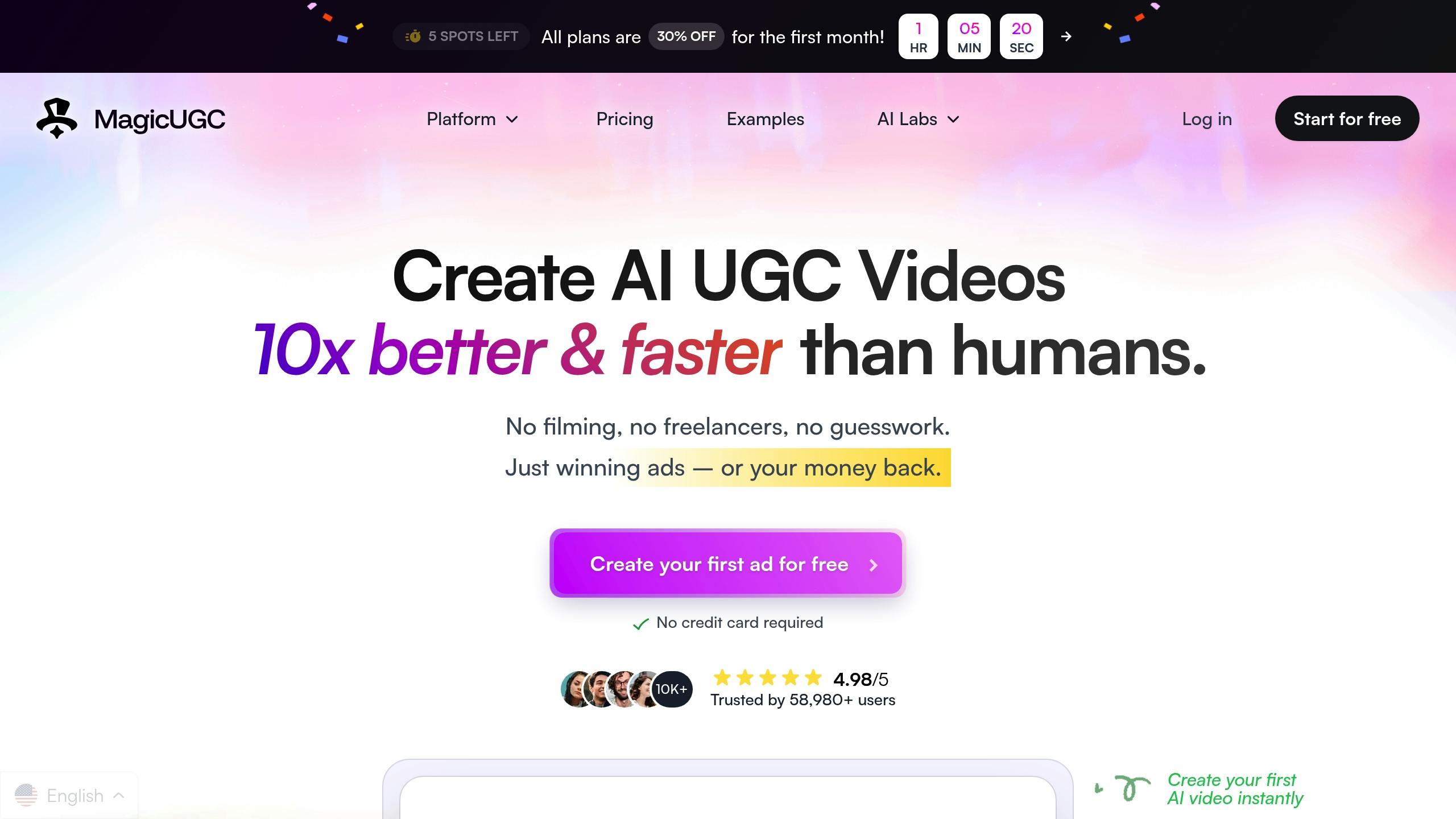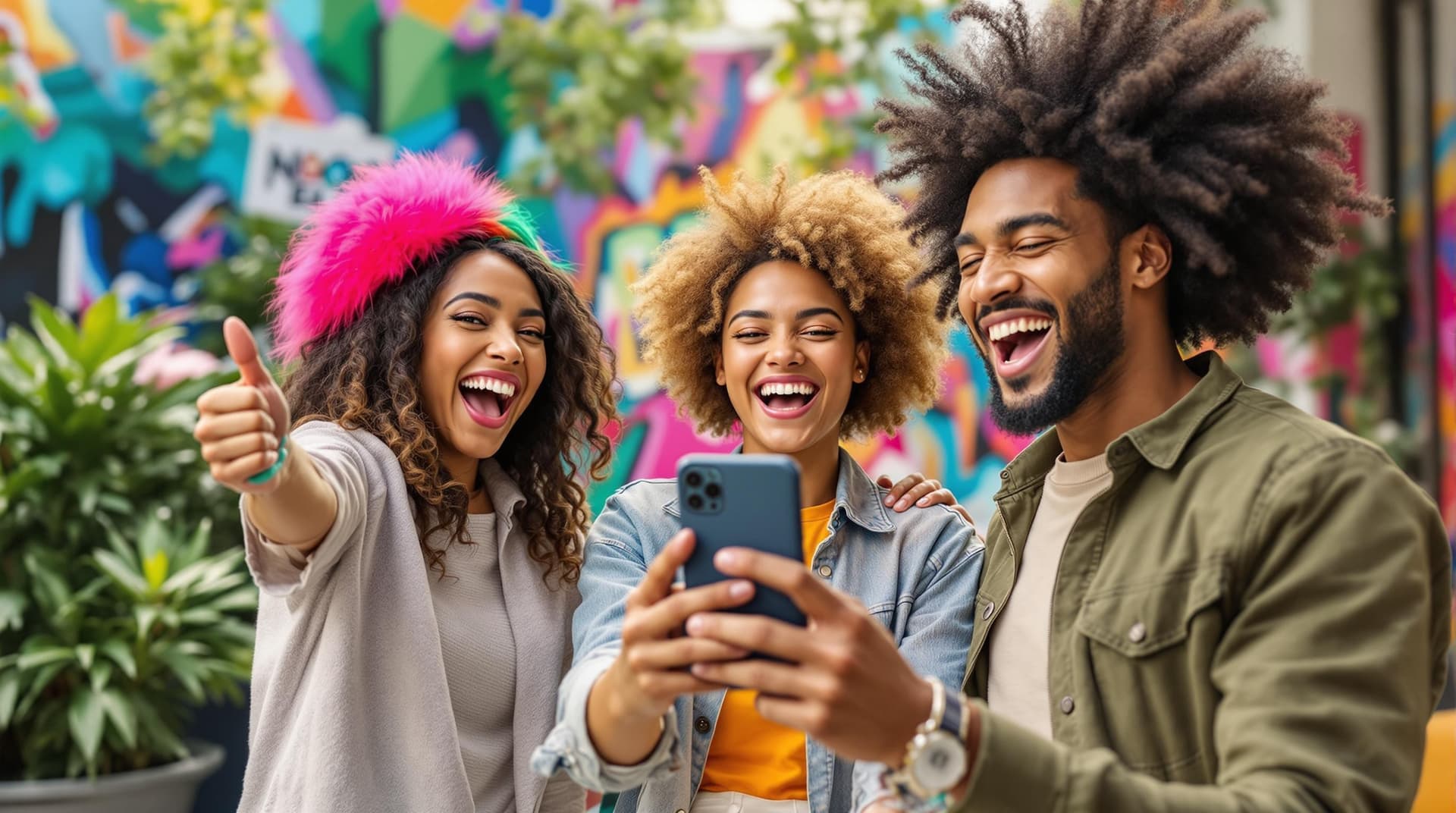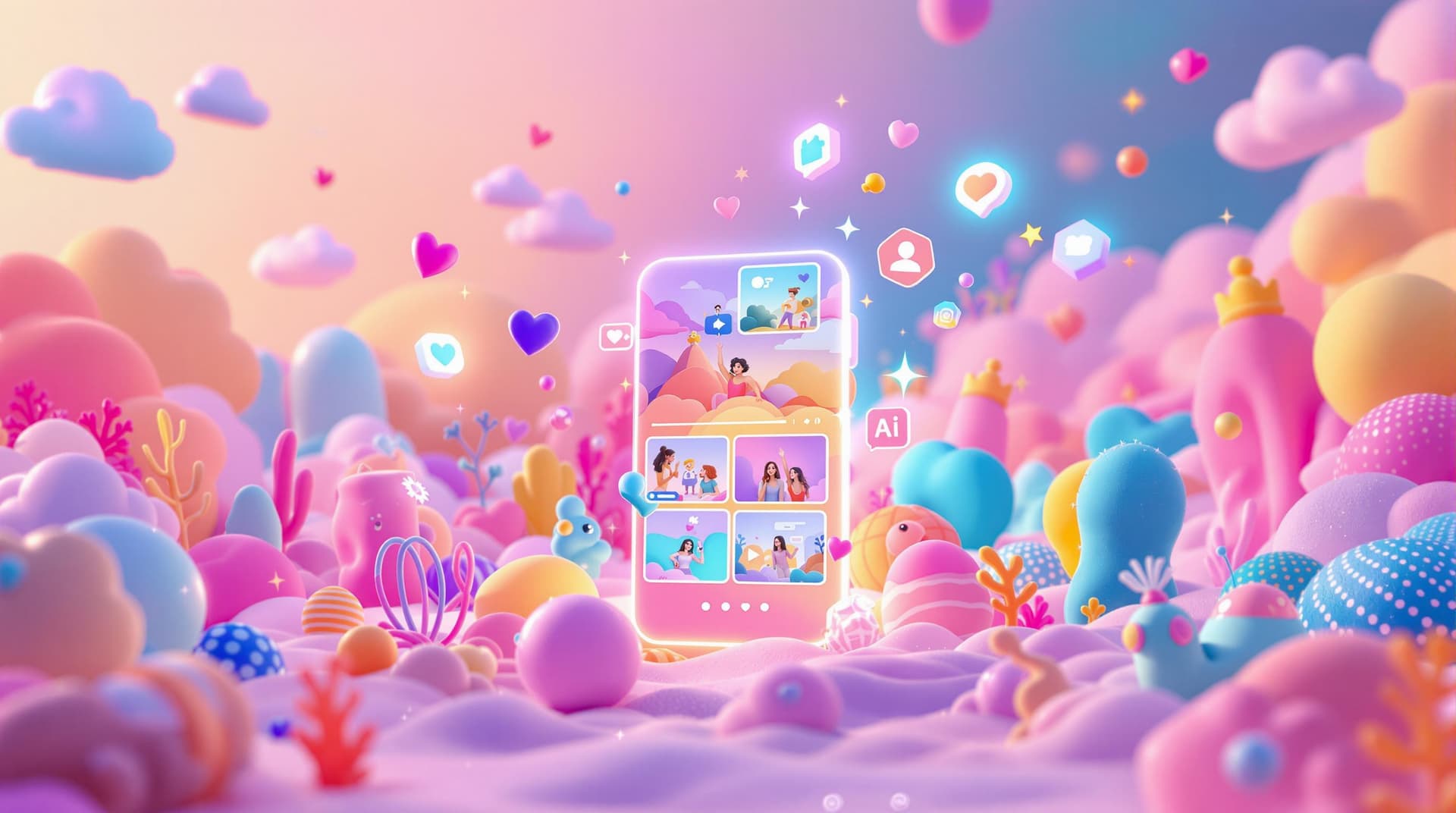
AI-generated user-generated content (UGC) is reshaping marketing in 2025. It’s faster, cheaper, and more scalable than human-created UGC, but emotional connection and trust still give traditional methods an edge. Here's what you need to know:
- Cost: AI UGC costs as little as $99/month for unlimited videos, while human UGC ranges from $150 to $212 per video.
- Engagement: AI content achieves up to 350% higher engagement rates, with TikTok campaigns showing 18.5% engagement vs. 5.3% for human UGC.
- Scalability: AI can produce thousands of videos in minutes, while traditional methods are limited by human capacity.
- Speed: AI creates 1,000 videos in 2 hours; human methods take months.
- Trust: 62% of consumers initially distrust AI content, but this improves with high-quality examples.
Quick Comparison
| Factor | AI UGC | Traditional UGC |
|---|---|---|
| Cost per Video | $99/month (unlimited) | $150-$212 per video |
| Engagement Rate | Up to 18.5% (TikTok) | 5.3% (TikTok) |
| Production Speed | Minutes for thousands | Weeks or months |
| Scalability | Thousands of variations | Limited by human effort |
| Emotional Impact | Moderate (63%) | Higher (81%) |
AI UGC is ideal for brands prioritizing scale, speed, and cost-efficiency, while human UGC remains valuable for emotional connection and authenticity. A blend of both can maximize results.
How I Make Viral UGC Ads Using AI | Step by Step Guide
Cost Analysis: AI vs Human UGC
As brands shift towards scalable solutions, AI offers a cost-effective way to meet the growing demand for high-volume, low-cost content. MagicUGC's reported 90% cost savings highlight the financial edge AI brings to modern campaigns.
AI UGC Production Costs
AI-powered UGC platforms typically use subscription models, offering predictable and scalable pricing:
- Basic Plan: $99/month (20 videos)
- Turbo Plan: $249/month (unlimited videos)
- Enterprise Option: $1-$5 per video
Human UGC Production Costs
Creating UGC through traditional methods can cost anywhere from $100 to $10,000 per post, depending on the creator's follower count. Additional hidden fees, such as agency markups and legal reviews, often add 20-50% more to the total cost.
Side-by-Side Cost Comparison
Here's a breakdown of costs for a typical marketing campaign:
| Cost Factor | AI UGC | Traditional UGC |
|---|---|---|
| Base Production | $249/month (unlimited) | $150-$212 per video[12] |
| Multi-Language | Included | 50-100% extra per language[2][9] |
| Revisions | Instant, no cost | 50-100% of original cost |
| Usage Rights | Unlimited | 20-50% extra per year |
| A/B Testing | $1-$5 per variation[2] | $1,250-$5,000 per test[2] |
This comparison highlights the substantial cost advantages of AI-driven UGC. These savings also align with the engagement benefits explored in the upcoming Results section, making AI a key tool for brands embracing the 'test fast, scale faster' approach to marketing in 2025.
Results: Engagement and Sales Data
The cost savings from AI-generated UGC directly contribute to improved performance metrics. By 2025, AI-driven content has clearly outpaced traditional UGC in both engagement and conversions across platforms.
Engagement Rate Comparison
The platform-specific data highlights some major differences:
| Platform | AI UGC | Traditional UGC |
|---|---|---|
| 7.2% | 2.1% | |
| TikTok | 18.5% | 5.3% |
| Email Marketing | +32% open rate | Industry average |
AI-generated videos stand out with 2.8x more views and 3.5x more shares compared to human-created content. For instance, a food delivery app's AI-powered TikTok campaign achieved 12 million views, far surpassing the 4 million views garnered by influencer content.
Sales and ROI Numbers
AI UGC has a noticeable impact on sales and return on investment (ROI). E-commerce data reveals:
- 45% higher conversion rates on average compared to traditional UGC[6].
- 2.5x higher return on ad spend (ROAS) for AI-driven campaigns.
"Our beauty brand saw ROAS increase from $3.20 to $8.00 for every dollar spent after implementing AI UGC solutions", according to a MagicUGC customer success story.
Output Quality and Volume
AI-generated UGC offers a clear advantage in volume while maintaining consistent quality:
- Earns 68% consumer quality approval[2].
For example, a fashion retailer managed to produce 1,000 AI videos per week, compared to just 100 through influencers. This allowed them to amplify brand recognition with consistent messaging.
However, while AI excels in quantitative metrics, traditional UGC still holds an advantage in perceived authenticity (81% vs. 63%)[2]. Interestingly, this gap narrows when the content's origin is undisclosed, suggesting that biases against AI content may lessen as the technology continues to evolve.
sbb-itb-d822133
Production Speed and Scale
Cost savings and increased engagement are important, but the real game-changer with AI is how much faster and more scalable it makes production. As AI keeps advancing, the gap in efficiency between AI-driven and traditional methods grows wider.
Time to Create: AI vs. Human
AI drastically cuts down production time:
| Content Volume | AI UGC | Traditional UGC |
|---|---|---|
| Single Video | Less than 1 minute | 2-4 hours |
| 100 Videos | Around 10 minutes | 2-3 weeks |
| 1000 Videos | About 2 hours | 2-3 months |
This speed is a direct factor in the 90% cost savings and 350% engagement improvements mentioned earlier[6].
Multi-Language Content Creation
AI's ability to create content in dozens of languages at the same time has transformed global marketing. While human creators usually focus on 1-3 languages, AI tools can handle over 40 languages simultaneously[11].
"The ability to instantly create localized content across markets reduced our time-to-market by 90% compared to traditional methods", shared a MagicUGC enterprise customer[4].
This allows brands to:
- Launch global campaigns with tailored messaging for each market.
Testing and Optimization Speed
AI also speeds up testing and optimization cycles. Traditional A/B testing can take weeks to assess a few variations. AI, on the other hand, enables quick iterations and real-time performance adjustments[1].
| Testing Phase | AI UGC | Traditional UGC |
|---|---|---|
| Content Creation | Minutes | Days |
| Testing Period | Hours | Weeks |
| Data Analysis | Real-time | 3-5 days |
This faster cycle has a direct impact on ROI, creating a snowball effect that boosts overall performance.
Trust and Perception Issues
AI shines when it comes to speed and cost, but trust remains a major hurdle. A survey shows 62% of consumers initially distrust AI-generated content. However, this drops to 41% once they see high-quality examples[1]. This trust gap can undermine AI's cost and engagement benefits if not addressed.
How Viewers React to AI Content
Reactions to AI content differ by age group:
| Age Group | Trust in AI UGC | Key Preferences |
|---|---|---|
| 18-34 | High (57%) | Focuses on usefulness over origin |
Research from TrustMetrics (2025) highlights that clear AI disclosure increases viewer trust by 24%[7]. This underscores the importance of transparent communication from brands.
Content Style Differences
AI and human-generated content each bring unique strengths. According to ContentComparison:
"AI UGC excels in product descriptions with 30% more detailed content and how-to guides with 25% clearer instructions. However, human UGC achieves 40% higher emotional connection"[14].
Nike demonstrates this balance by pairing AI-generated content with human edits for a more relatable touch[8].
Social Media Platform Rules
Disclosure rules on social platforms add a layer of complexity to AI's scalability:
- Instagram/TikTok: Require "AI-Created" labels[13]
- Facebook: Displays AI contribution percentages[4]
- LinkedIn: Needs clear disclosure in the first line[5]
- Twitter (X): Prioritizes content verified by humans[15]
Marketers are adapting, with 62% agreeing that transparency about AI usage is crucial for maintaining trust[11]. As these policies evolve, brands must strike a balance between leveraging AI and meeting the public's expectations for honesty.
MagicUGC Results and Data

MagicUGC's platform stands out by delivering measurable improvements through three core areas: cost savings, AI-driven tools, and scalable performance.
MagicUGC Cost Savings
The Turbo Plan from MagicUGC has reshaped content creation costs for businesses moving away from traditional UGC methods:
| Cost Factor | Traditional UGC | MagicUGC Turbo Plan | Savings |
|---|---|---|---|
| Monthly Content Cost | $10,000 | $1,000 | 90% |
With a $249/month unlimited video model, businesses can scale content affordably compared to the hefty $150-$212 per video costs seen in traditional UGC.
Performance-Boosting Tools
MagicUGC offers AI-powered tools that refine content for better results:
- AI Script Generator: Produces brand-consistent scripts in seconds.
- Multi-Avatar Selection: Ensures representation across various demographics.
- Hook Matrix: Balances educational and entertaining elements for optimized engagement[10].
For example, an electronics retailer achieved a 220% boost in video completion rates by using targeted content variations powered by these tools[3].
Customer Success Metrics
The platform's impact is evident through real-world data, showing consistent improvements across key metrics:
| Metric | AI Improvement | Traditional Benchmark | Time Period |
|---|---|---|---|
| Instagram Engagement | 8.7% | 2.5% | 30 days |
| Video Completion Rate | +220% | Baseline | Q1 2025 |
| Ad Click-Through Rate | +180% | Baseline | 60 days |
These results highlight how MagicUGC consistently delivers scalable performance, addressing earlier concerns about trust and reliability.
Conclusion: Making the Choice
Key Comparison Highlights
AI-generated UGC stands out in performance, cutting costs by 90% and boosting engagement by 350%, all while producing 10 times more content compared to older methods[10][12]. These results are tied to AI's ability to quickly test and refine content variations, all while keeping a consistent brand image across high volumes.
Important Implementation Insights
As mentioned in Trust and Perception Issues, traditional UGC isn't being tossed aside. Many brands are succeeding by blending AI-powered efficiency with human oversight[6]. This mix helps maintain a sense of authenticity while taking full advantage of AI's ability to scale content production.
Starting with AI UGC
When introducing AI UGC, focus on strategic rollout. Start small with pilot campaigns, using tiered platform plans to compare results against your current content. Target specific campaigns or product categories first, and then expand gradually.
To ensure quality while scaling up, keep these factors in mind:
| Factor | Consideration | Impact |
|---|---|---|
| Content Volume | Monthly video needs | Guides AI platform choice |
| Brand Voice | Style guidelines | Shapes AI content output |
| Budget | Cost per video goal | Helps allocate resources |
| Timeline | Launch schedule | Defines rollout phases |
Using real-time analytics will help you fine-tune campaigns on the go, ensuring consistent improvements as you scale.



%26description%3DExplore%2520the%2520cost%2520and%2520engagement%2520differences%2520between%2520AI-generated%2520and%2520traditional%2520user-generated%2520content%2520in%25202025%2520marketing%2520strategies.%26image%3Dhttps%3A%2F%2Fwww.magicugc.com%2Fblog-images%2Fassets.seobotai.com%2Fmagicugc.com%2F67b0368b43f298fa835aa7c9-1739604098514.jpg&w=3840&q=75)